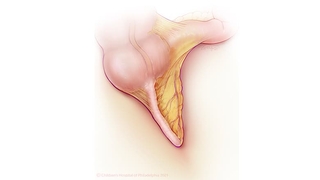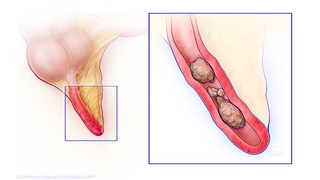What is appendicitis?
Appendicitis is an infection or inflammation of the appendix, a pinky-sized, tube-like structure part of the large intestine. The appendix is located in the right lower section of the abdomen in most children.

The appendix is a pinky-sized, tube-like structure located in the right lower section of the abdomen.
What causes appendicitis in a child?
Appendicitis is the result of a blockage of the appendix caused by hard mucus or stool, or swelling caused by a virus. The blockage causes the appendix to swell and become inflamed. If the swelling and infection are left untreated, the appendix can burst (perforate), causing the contents of the appendix to be released into the abdomen, spreading the infection.

When infected, the appendix becomes swollen and inflamed (pictured on the left). Sometimes, this is caused by a blockage with mucous or hard stool (pictured on the right).
Appendicitis is the most common cause of emergency abdominal surgery in children. Though it can happen at any age, appendicitis occurs more frequently in school-aged children, and rarely occurs under the age of 1.
Appendicitis symptoms
The signs and symptoms of appendicitis can vary from child to child. The most common symptoms of appendicitis in children are:
- Abdominal pain that begins around the belly button and moves to the right lower side of the abdomen. The pain typically increases when walking, jumping or coughing, and usually worsens as time goes on.
- Fever
- Nausea and/or vomiting
- Loss of appetite
- Diarrhea
Testing and diagnosis
Appendicitis is diagnosed with a thorough health history and physical examination. Your child may need to have an imaging study completed, such as an ultrasound, MRI or CT scan, to see the appendix. Your child may also have laboratory studies completed, such as a complete blood count (CBC), to determine the extent of the infection.
Appendicitis treatments
Appendectomy in Children
Immediately following diagnosis, patients with appendicitis will receive antibiotics to treat the infection.
Ultimately, the treatment for appendicitis is a surgery to remove the appendix, called an appendectomy. Your child’s surgeon will help determine the best treatment for your child.
When to call the doctor after surgery
Please call us if your child has any of the following after appendicitis surgery:
- Fever greater than 101.5 degrees F
- Vomiting or inability to tolerate any food or liquids
- Increasing or continuous abdominal pain
- Abdominal distention (swollen or enlarged)
- Drainage from incision(s)
- Redness or swelling of the incision(s)
- If you have any further questions or concerns
Appendicitis is considered an emergent condition, requiring immediate attention. If you think that your child may have appendicitis, please have them evaluated at the Emergency Department.

Why choose CHOP for your child's surgery
If your child needs surgery, you want to know their care is in the hands of the best, most compassionate team. CHOP's world-class pediatric surgeons and experienced staff are here for you.

Preparing for surgery
Find tips to prepare for your preoperative visit with CHOP’s pediatric general surgeons, and resources to help prepare your child for surgery.
Resources to help
Division of Pediatric General, Thoracic and Fetal Surgery Resources
We have created resources to help you find answers to your questions and feel confident with the care you are providing your child.
Reviewed by Edward J. Doolin, MD, FACS, FAAP
